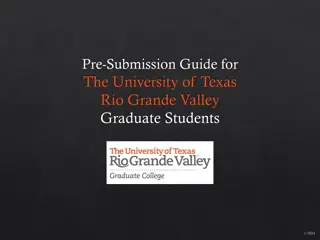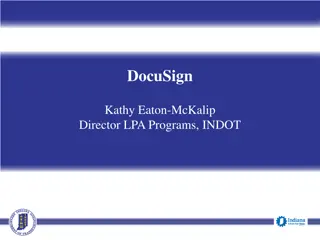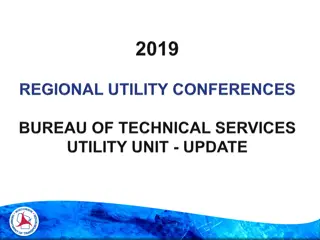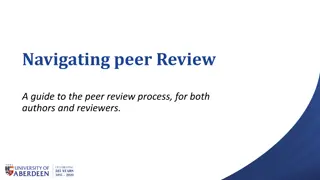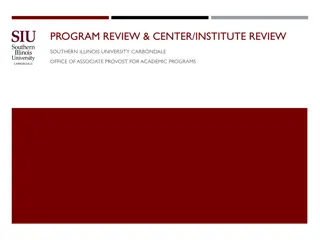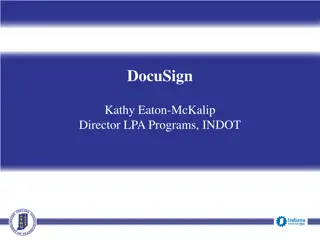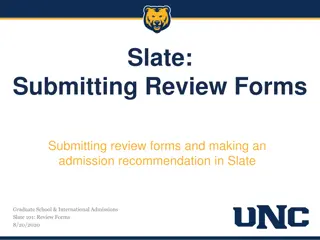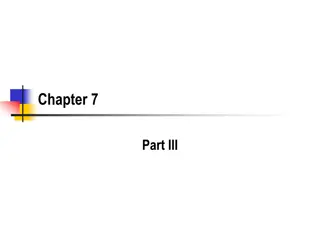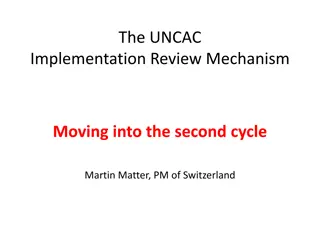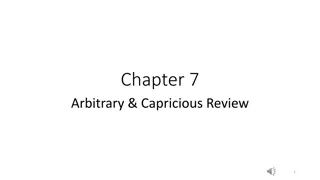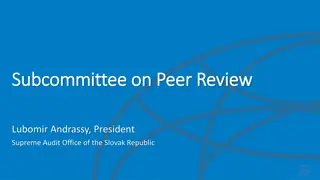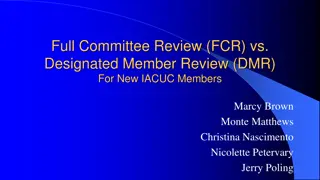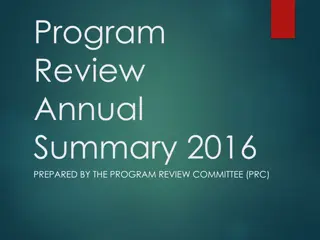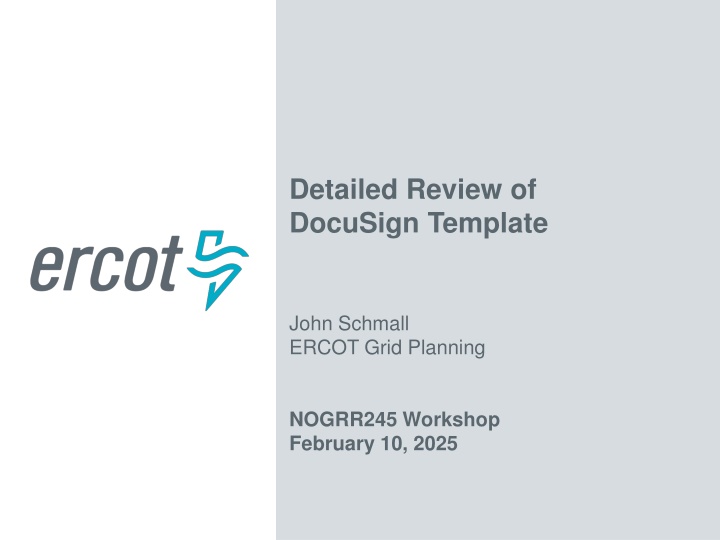
Enhancing Frequency Ride-Through Capability for Grid Planning Workshop
"Explore the detailed review of a DocuSign template used in a workshop focusing on grid planning, specifically examining frequency ride-through capability, modifications, and interconnection agreements."
Download Presentation

Please find below an Image/Link to download the presentation.
The content on the website is provided AS IS for your information and personal use only. It may not be sold, licensed, or shared on other websites without obtaining consent from the author. If you encounter any issues during the download, it is possible that the publisher has removed the file from their server.
You are allowed to download the files provided on this website for personal or commercial use, subject to the condition that they are used lawfully. All files are the property of their respective owners.
The content on the website is provided AS IS for your information and personal use only. It may not be sold, licensed, or shared on other websites without obtaining consent from the author.
E N D
Presentation Transcript
Detailed Review of DocuSign Template John Schmall ERCOT Grid Planning NOGRR245 Workshop February 10, 2025
General Information Resource Entity Name: [pre-populated] Resource Entity Data Universal Numbering System (DUNS) Number: [pre-populated] Substation Name: [pre-populated] Resource Name: [pre-populated] Fuel Type: [pre-populated] (if fuel type = wind) Wind Turbine Type : [pre-populated] Does the Resource have a Standard Generation Interconnection Agreement (SGIA) date prior to August 1, 2024? Has the Resource implemented any modification covered by ERCOT Planning Guide Section 5.2.1(1)(c) since its original Commercial Operation Date (COD)? Was the most recent Generation Interconnection or Modification (GIM) covered by ERCOT Planning Guide Section 5.2.1(1)(c) initiated prior to August 1, 2024? [y/n] [y/n] (if above = y) [y/n] 2 PUBLIC
Frequency Ride-Through Q1 & Q2 Is the Resource frequency ride-through capability (i.e., software, settings, firmware, and parameterization) set to the maximum level the equipment allows? [y/n] (If Yes) As of what date did the Resource maximize its frequency ride-through capability? [date] (If Yes) Describe all software, firmware, settings or parameterization modifications the Resource owner implemented to maximize the Resource s frequency ride-through capability to the fullest extent the equipment allows. [text] (If No) Will the Resource maximize its frequency ride-through capability on or before 12/31/25 or by its initial synchronization date (for new IBRs synchronizing after 12/31/25)? [y/n] (if yes to above question) Provide the date you intend to complete the maximization and describe the software, firmware, settings or parameterization changes you will make to maximize the Resource s frequency ride-through capability. [date] [text] Will the Resource owner implement changes to existing equipment other than software, firmware, settings or parameterization changes to increase the Resource s frequency ride-through capability? [y/n] (If Yes) Describe the changes to existing equipment other than software, firmware, settings or parameterization changes that will be made to increase the Resource s frequency ride-through capability and attach any supporting documentation. [text] [attachment point] 3 PUBLIC
Frequency Ride-Through Q3 & Q4 Frequency ride-through capability (seconds) Frequency(Hz) Required Pre-Maximization Post-Maximization 61.8 299 [number] [number] 61.6 540 [number] [number] 58.8-61.2 continuous [continuous/not-continuous] [continuous/not-continuous] 58.4 540 [number] [number] 57 299 [number] [number] I attest the table above accurately represents the frequency ride-through performance capability of the Resource and all its inter-dependent systems (such as plant controls, turbine controls and/or inverter controls - not just protective relay settings). [y/n] Provide a complete frequency ride-through capability curve (0-600 seconds) superimposed on the minimum applicable requirement: [attachment point] 4 PUBLIC
Frequency Ride-Through Curve Example 5 PUBLIC
Frequency Ride-Through Q5 & Q6 Can the Resource meet or exceed - or will the Resource meet or exceed by 12/31/25 or at the time of its synchronization with the ERCOT Transmission Grid (for new IBRs synchronizing after 12/31/25) - the minimum frequency ride-through requirements in Nodal Operating Guide Sections 2.6.2.1(1) - (5)? [y/n] (If Yes) As of what date did or by what date will - the Resource meet the requirements in NOG Sections 2.6.2.1(1) (5)? [date] (If No) Submit the Initial Frequency Ride-Through Capability Report required in NOG Section 2.11.1(1). [text] [attachment point] (If No) Does the Resource meet the frequency ride-through requirements in effect on May 1, 2024 at this time? [y/n] Can the Resource currently remain reliably connected to the ERCOT grid as set forth in NOG Section 2.6.2.1.1(2)? [y/n] (If No) Submit the Initial Frequency Ride-Through Capability Report required in NOG Section 2.11.1(1). [text] [attachment point] 6 PUBLIC
Frequency Ride-Through Q7 & Q8 I attest the Resource owner has made or caused to be made all software, settings, firmware, and parameterization changes (which includes memory upgrades to accommodate such changes that do not involve modifying other Resource equipment or components) to maximize the performance of the Resource s protection systems, controls, and other plant equipment (within equipment limitations) to exceed or achieve as close as reasonably possible, the capability and performance requirements set forth in Nodal Operating Guide Section 2.6.2.1. [y/n] I attest all submitted dynamic models including PSSE, TSAT, and PSCAD for this Resource are accurate and reflect actual frequency ride-through capability. [y/n] (If No) Explain why the models are not accurate or do not reflect actual frequency ride-through capability. [text] 7 PUBLIC
Voltage Ride-Through Q1 & Q2 Is the Resource voltage ride-through capability (i.e., software, settings, firmware, and parameterization) set to the maximum level the equipment allows? [y/n] (If Yes) As of what date did the Resource maximize its voltage ride-through capability? [date] (If Yes) Describe all software, firmware, settings or parameterization modifications the Resource owner implemented to maximize the Resource s voltage ride-through capability to the fullest extent the equipment allows. [text] (If No) Will the Resource maximize its voltage ride-through capability on or before 12/31/25 or by its initial synchronization date (for new IBRs synchronizing after 12/31/25)? [y/n] (if yes to above question) Provide the date you intend to complete the maximization and describe the software, firmware, settings or parameterization changes you will make to maximize the Resource s voltage ride-through capability. [date] [text] Will the Resource owner implement changes to existing equipment other than software, firmware, settings or parameterization changes to increase the Resource s voltage ride-through capability? [y/n] (If Yes) Describe the changes to existing equipment other than software, firmware, settings or parameterization changes that will be made to increase the Resource s voltage ride-through capability and attach any supporting documentation. [text] [attachment point] 8 PUBLIC
Voltage Ride-Through Q3 Ride-through capability (seconds) Legacy Requirements Preferred Requirements (WGR / PVGR or ESR) POIB Voltage (pu) Pre-Maximization Post-Maximization 1.8 May trip 0.0002* [number] [number] 1.7 May trip 0.001* [number] [number] 1.6 May trip 0.003* [number] [number] 1.4 May trip 0.015* [number] [number] 1.2 0.2 1.0 [number] [number] 1.175 0.5 1.0 [number] [number] 1.15 1.0 1.0 [number] [number] [continuous/not- continuous] [continuous/not- continuous] 0.9 - 1.1 continuous continuous 0.7 1.394 3.0 / 6.0 [number] [number] 0.5 1.039 2.5 / 3.0 [number] [number] 0.25 0.594 1.2 [number] [number] 0.13 0.381 0.381 [number] [number] 0 0.15 0.16 / 0.32 [number] [number] * These requirements are from IEEE 2800-2022 9 PUBLIC
Voltage Ride-Through Q3 & Q4 I attest the table above accurately represents the voltage ride-through performance capability of the Resource and all its inter-dependent systems (such as plant controls, turbine controls and/or inverter controls - not just protective relay settings). [y/n] Provide a complete voltage ride-through capability curve (0-600 seconds) superimposed on the minimum applicable requirement. A separate curve may be necessary to show sub-cycle overvoltage capability for resources subject to IEEE 2800-2022 requirements. [attachment point] 10 PUBLIC
VRT Curve Example - Legacy 11 PUBLIC
VRT Curve Example - Preferred 12 PUBLIC
Sub-cycle Overvoltage Curve Example 13 PUBLIC
Voltage Ride-Through Q5 Can the Resource meet or exceed - or will the Resource meet or exceed by 12/31/25 - all the voltage ride-through requirements in Nodal Operating Guide Sections 2.9.1.1(1) (7)? [y/n] (If Yes) As of what date did or by what date will - the Resource meet the requirements in NOG Sections 2.9.1.1(1) (7)? [date] (If No) Does the Resource meet or exceed - or will the Resource meet or exceed by 12/31/25 - all the voltage ride-through requirements in NOG Sections 2.9.1.2(1) (7) at this time? [y/n] (if No) Submit the Initial Voltage Ride-Through Capability Report required in NOG Section 2.11.2(1). [text] [attachment point] (if No) Does the Resource meet the voltage ride-through requirements in effect on May 1, 2024 at this time? [y/n] 14 PUBLIC
Voltage Ride-Through Q6. Q7, Q8 & Q9 Do all instantaneous over-current or over-voltage protection systems installed and activated to trip the Resource use filtered quantities or time delays sufficient to prevent misoperation while providing the desired equipment protection? [y/n] Does all alternating current instantaneous over-voltage protection that could disrupt power output use a measurement period of at least one cycle (of fundamental frequency)? [y/n] Does the Resource use Rate of Change of Frequency measurement quantities to reduce power output or trip offline during fault conditions and subsequent recovery to a steady-state operating point within the applicable ride-through profiles in NOG Section 2.9.1.1(1) or 2.9.1.2(1)? [y/n] Does the Resource use phase angle jump measurement quantities to reduce power output or trip offline during fault conditions and subsequent recovery to a steady-state operating point within the applicable ride-through profiles in NOG Section 2.9.1.1(1) or 2.9.1.2(1)? [y/n] 15 PUBLIC
Voltage Ride-Through Q10 & Q11 I attest the Resource owner has made or caused to be made all software, settings, firmware, and parameterization changes (which includes memory upgrades to accommodate such changes that do not involve modifying other Resource equipment or components) to maximize the performance of the Resource s protection systems, controls, and other plant equipment (within equipment limitations) to exceed or achieve as close as reasonably possible, the capability and performance requirements set forth in Nodal Operating Guide Sections 2.9.1, 2.9.1.1 or 2.9.1.2, as applicable. [y/n] I attest all submitted dynamic models including PSSE, TSAT, and PSCAD for this Resource are accurate and reflect actual voltage ride-through capability. [y/n] (If No) Explain why the models are not accurate or do not reflect actual voltage ride-through capability. [text] 16 PUBLIC
IEEE 2800-2022 Q1 Has the Resource owner maximized the Resource s capabilities with respect to the requirements in IEEE 2800-2022 Sections 5, 7, and 9 to the fullest extent the equipment allows? [y/n] (If Yes) As of what date did the Resource maximize its capabilities with respect to the requirements in IEEE 2800-2022 Sections 5, 7, and 9 to the fullest extent the equipment allows? [date] (If Yes) Describe all software, firmware, settings or parameterization modifications the Resource implemented to maximize the Resource s capabilities with respect to the requirements in IEEE 2800-2022 Sections 5, 7, and 9 to the fullest extent the equipment allows. [text] (If No) Will the Resource maximize it capabilities with respect to the requirements in IEEE 2800- 2022 Sections 5, 7, and 9 to the fullest extent the equipment allows on or before 12/31/25 or by its Commercial Operations Date? [y/n] (if yes to above question) Provide the date you intend to complete the maximization and describe the software, firmware, settings or parameterization changes you will make to increase the Resource s capabilities with respect to the requirements in IEEE 2800-2022 Sections 5, 7, and 9 to the fullest extent the equipment allows. [date] [text] 17 PUBLIC
IEEE 2800-2022 Q2 & Q3 Can the Resource meet or exceed - or will the Resource meet or exceed by 12/31/25 (or its Commercial Operations Date) - the capability and performance set forth in sections 5, 7 and 9 of the IEEE 2800- 2022? [y/n] (If Yes) As of what date did - or by what date will - the Resource meet or exceed the requirements in IEEE 2800-2022 Sections 5, 7, and 9 to the fullest extent the equipment allows? [date] (If No) Describe which parts of IEEE 2800-2022 Sections 5, 7 and 9 the Resource can meet (if any) and which it cannot meet. [text] Will the IBR be configured to inject negative sequence current for unbalanced faults (in addition to increased positive-sequence reactive current) as described in IEEE 2800 Section 7.2.2.3.4? [y/n] (If No) Describe why the Resource has not been configured to inject negative sequence current for unbalanced faults (in addition to increased positive-sequence reactive current). [text] (If Yes) Complete the following table and provided additional explanation if necessary. Parameter Pre-Maximization Post-Maximization Requirement Negative Sequence Current Injection allowable range to lead negative sequence voltage 90 to 100 degrees (90 to 150 for Type 3 WGR) [number] degrees [number] degrees 18 PUBLIC
IEEE 2800-2022 Q4 & Q5 Complete the following IBR Performance Specifications per IEEE 2800-2022 Section 7.2.2.3.5, Table 13. Parameter Pre-Maximization Post- Maximization Requirement IBR unit Step Response Time 2.5 cycles (NA for Type 3 WGR) 4 cycles ; 6 cycles for Type 3 WGR -2.5% / +10% of IBR unit max current [number] cycles [number] cycles IBR unit Settling Time [number] cycles [number] cycles [#]% / [#]% of IBR unit maximum current [#]% / [#]% of IBR unit maximum current IBR unit Settling band Does the Resource use current blocking? [y/n] (If Yes) Please describe any use of current blocking to ride through disturbances. Note: Current blocking is not allowed within the continuous or mandatory operations regions ( no trip zones ) and, if used in the may trip regions, current exchange must restart in 5 cycles (IEEE 2800-2022 Section 7.2.3). [text] [attachment point] (If Yes) Provide restart time in the following table: Parameter Requirement Pre-Maximization Post-Maximization Restart time after return to mandatory operations region <5 cycles [number] cycles [number] cycles 19 PUBLIC
IEEE 2800-2022 Q6 & Q7 Provide the Rate of Change of Frequency ride-through capability in the following table (See IEEE 2800- 2022 Section 7.3.2.3.5): Parameter Requirement Pre-Maximization Post- Maximization Rate of Change of Frequency (RoCoF) (df/dt) 5 Hz/s [number] Hz/s [number] Hz/s RoCoF average measuring window >.1 sec [number] seconds [number] seconds Provide the phase angle jump (change) ride-through capability in the following table (See IEEE 2800- 2022 Section 7.3.2.4): Parameter Requirement Pre-Maximization Post- Maximization Phase angle jump (change) 25 deg [number] degrees [number] degrees 20 PUBLIC
IEEE 2800-2022 Q8, Q9 & Q10 Provide consecutive voltage deviations ride-through data (See, IEEE 2800-2022 Section 7.2.2.4): Pre-Maximization Post- Maximization Parameter Requirement # of excursions in a 10 second window 4 [number] [number] # of excursions in a 120 second window 6 [number] [number] # of excursions in an 1800 second window 10 [number] [number] # of excursions below 50% at POI in a 10 second window # of excursions below 50% in a 120 second window 2 [number] [number] 3 [number] [number] I attest the Resource owner has collaborated with the interconnecting TSP(s) to ensure any auto- reclosing settings are coordinated with the Resource multiple fault ride-through capability to not result in unnecessary tripping of the Resource. [y/n] I attest the Resource owner has made all software, settings, firmware, and parameterization changes (which includes memory upgrades to accommodate such changes that do not involve modifying other Resource equipment or components) to maximize the performance of the Resource s protection systems, controls, and other plant equipment (within equipment limitations) to exceed, or achieve as close as reasonably possible, the capability and performance set forth in Sections 5, 7 and 9 of the IEEE 2800-2022 standard. [y/n] 21 PUBLIC
Extension Request Are you requesting an extension for the Resource under Nodal Operating Guide Sections 2.6.2.1(7); 2.9.1(6); 2.9.1.1(8) or (9); or 2.9.1.2(9)? [y/n] (If Yes) Provide complete the following table: Section for which you request and extension If yes, date on which you want the extension to end Yes/No Section 2.6.2.1(7) Yes/No (If yes) [date] Section 2.9.1(6) Yes/No (If yes) [date] Section 2.9.1.1(8) Yes/No (If yes) [date] Section 2.9.1.1(9) Yes/No (If yes) [date] Section 2.9.1.2(9) Yes/No (If yes) [date] (If Yes) What is the Resource s Commercial Operations Date? [date] (If Yes) For each section you are requesting an extension, provide the information set forth in NOG Sections 2.11.1 (for frequency ride-through extensions) or 2.11.2 (for voltage ride-through extensions). [text] [attachment point] (If Yes) Provide the information set forth in NOG Section 2.12.1.2 as applicable for the extension requested. [text] [attachment point] 22 PUBLIC
Exemption Request Do you intend to request an exemption pursuant to Nodal Operating Guide Section 2.6.2.1(7) for the Resource? [y/n] (If Yes) Specify the sub-section(s) of NOG Section 2.6.2.1 for which you seek the exemption and provide the information set forth in NOG Section 2.11.1: [text] [attachment point] Section 2.6.2.1(1)? [y/n] Section 2.6.2.1(3)? [y/n] Section 2.6.2.1(4)? [y/n] Section 2.6.2.1(5)? [y/n] Section 2.6.2.1(6)? [y/n] Do you intend to request an exemption pursuant to Nodal Operating Guide Section 2.9.1.2(9) for the Resource? [y/n] (If Yes) Specify the sub-section(s) of NOG Section 2.9.1.2 for which you seek the exemption and provide the information set forth in NOG Section 2.11.2: [text] [attachment point] Section 2.9.1.2(1)? [y/n] Section 2.9.1.2(3)? [y/n] Section 2.9.1.2(4)? [y/n] Section 2.9.1.2(5)? [y/n] Section 2.9.1.2(6)? [y/n] Do you intend to request an exemption pursuant to Nodal Operating Guide Section 2.9.1(5)? [y/n] (If Yes) Provide the information set forth in NOG Section 2.11.2. [text] [attachment point] 23 PUBLIC
Questions ? 24 PUBLIC




